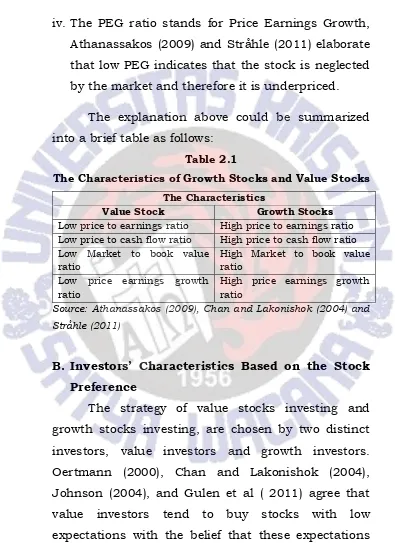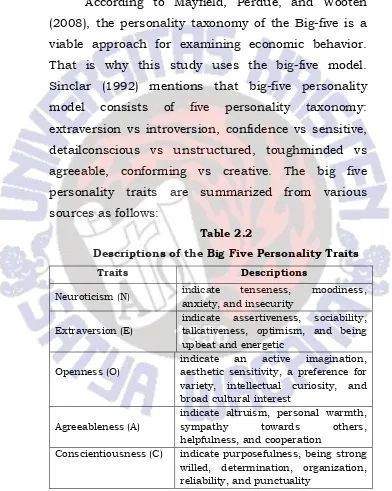CHAPTER II
REVIEW OF RELATED LITERATURE AND HYPOTHESIS DEVELOPMENT
This second chapter focuses on the related literature, in particular: stock preference, investors’ characteristics, demographic features, and big-five personality model. After the literature review, the hypotheses are developed.
A. Stocks Preferences
Stocks represent investors’ capital ownership in certain companies. Stocks preferences refer to the investors’ decision to choose or purchase certain stocks. Stocks themselves have different characteristics. In making decision, investors pay attention to these characteristics to decide whether or not preferring and buying the stocks. Swensen in Stråhle (2011) found that the most important choice an investor has to face is whether to invest in value or growth stocks.
the market corrects the price. While growth stocks are the stocks that are growing with the potential for continued growth. Since both contrary stocks have different characteristics, the previous study try to elaborate them into detail characteristics based on some measurements such as price earnings ratio, cash flow ratio, market to book value and price earnings growth (Stråhle, 2011). The detail characteristics of value and growth stocks are measured by some criteria as follows:
with a low P/E ratio is considered to be in the value category.
ii. The P/C ratio, or price in relation to the company’s cash flow, gives an indication of how low or high the price of the stock is in relation to the cash flow available. Athanassakos (2009), Chan and Lakonishok (2004) and Stråhle (2011) conclude that a low P/C ratio points out that the price was very low compared to the amount of cash flow that the company generates. Therefore, a stock with a low P/C ratio is considered to be in the value category.
iv. The PEG ratio stands for Price Earnings Growth, Athanassakos (2009) and Stråhle (2011) elaborate that low PEG indicates that the stock is neglected by the market and therefore it is underpriced.
[image:4.516.61.456.98.641.2]The explanation above could be summarized into a brief table as follows:
Table 2.1
The Characteristics of Growth Stocks and Value Stocks
The Characteristics
Value Stock Growth Stocks Low price to earnings ratio High price to earnings ratio Low price to cash flow ratio High price to cash flow ratio Low Market to book value
ratio
High Market to book value ratio
Low price earnings growth ratio
High price earnings growth ratio
Source: Athanassakos (2009), Chan and Lakonishok (2004) and
Stråhle (2011)
B. Investors’ Characteristics Based on the Stock Preference
are “too low” and the factors causing the stock to be “undervalue” are only temporary in nature. On the other hands, growth investors tend to buy stocks with high expectations, but with the bet that the expectations are also “too low” and will increase in time. The expectation refers to the price earnings ratio, cash to flow ratio, market to book value ratio and price earnings growth ratio.
Furthermore, the difference between value investor and growth investor is on the risk. Johnson (2004) states that value investors are reluctant to bet on the future, as they believe it is challenging to forecast accurately and, in general, are unwilling to pay much for future promises. Thus, value investors are risk averse. At the contrary, growth investors are risk takers. Risk is also related to certainty. They, who are in the high level of certainty, tend to be risk takers. While, they, who are in the low level of certainty, tended to be risk averse.
C. Factors that Influence Stock Preference 1) The Demographic Features
Mayfield, Perdue and Wooten (2008) state that demographic features provide the explanation of investment management decisions. Demographic features certainly influence the investment decision. Furthermore, some features are used to see whether they influenced the stock preference or not in particular: age, gender, and education.
First of all, age as one of the demographic features plays important role in decision whether to purchase the stocks or not. Age will also tell about the experience and level of certainty of the investors own. They, who closed to retirement, have higher level of certainty, tend to purchase the long-term stocks (Bhandari & Deaves, 2006). In other words, the more mature the investors are, they tend to prefer value stocks.
H1a: The elder investors tend to prefer value
stocks.
the risk to buy and sell quickly or in other words purchasing growth stocks. Men who are more overconfident tend to prefer growth stock in this case. However, according to Mayfield, Perdue, and Wooten (2008), men tend to prefer both short-term and long-term investment. In other words, men are likely to engage in either value or growth stocks. Since there are different result of men investors toward stock preference, this study explores on whether gender influence the stock preference or not and on men’s tendency toward value or growth stocks. The hypothesis will be:
H1b: Men investors tend to prefer growth stocks.
The third one of demographic features involved in this study is education. Education also plays important role in decision-making process. According to Bhandari & Deaves (2006), higher education levels were associates with certainty and knowledge the investors’ own. The more highly educated the investors, the more certain they are, the more risk takers they are. Thus, they tend to prefer growth stocks.
H1c:The higher level of education of the
2) The Big Five Personality Traits
[image:8.516.64.456.140.631.2]According to Mayfield, Perdue, and Wooten (2008), the personality taxonomy of the Big-five is a viable approach for examining economic behavior. That is why this study uses the big-five model. Sinclar (1992) mentions that big-five personality model consists of five personality taxonomy: extraversion vs introversion, confidence vs sensitive, detailconscious vs unstructured, toughminded vs agreeable, conforming vs creative. The big five personality traits are summarized from various sources as follows:
Table 2.2
Descriptions of the Big Five Personality Traits
Traits Descriptions
Neuroticism (N) indicate tenseness, moodiness, anxiety, and insecurity
Extraversion (E)
indicate assertiveness, sociability, talkativeness, optimism, and being upbeat and energetic
Openness (O)
indicate an active imagination, aesthetic sensitivity, a preference for variety, intellectual curiosity, and broad cultural interest
Agreeableness (A)
indicate altruism, personal warmth, sympathy towards others, helpfulness, and cooperation
Conscientiousness (C) indicate purposefulness, being strong willed, determination, organization, reliability, and punctuality
Some studies have proven that big five personality traits influence the investors in taking certain decision. Mayfield’s, Perdue’s, and Wooten’s study in 2008 has proven that the traits influence the short-term and long-term investing. Furthermore, Jamhidinavid, Chavoshani, and Amiri (2012) found that the traits influence the investment prejudices. Those traits are neuroticism, extraversions, openness, agreeableness, and conscientiousness. In addition, Mayfield, Perdue, and Wooten (2008) emphasize that one of the personality traits, which is agreeableness, does not significant towards the investment orientation. Thus, this study examines four personality traits, in particular: neuroticism, extraversion, openness to experience, and conscientiousness.
would be lack of confidence. Investors in type, the decision making processes they take, are influenced by their anxiety, nervousness and moodiness. If there are such negative information in stock trading, they would easily purchase or sell their stocks, because they are afraid that they hold the loss stocks. In other words, investors in this type of traits would not hold the stocks too long. Thus, investors with neuroticism tend to prefer growth stocks. The hypotheses will be:
H2:Investors with high level of neuroticisms
tend to prefer growth stocks.
found that investors with extraversions engage to long-term investing. In other words, investors with extraversions will tend to prefer value stocks.
H3:Investors with high level of extraversions
tend to prefer growth stocks.
The third one is openness to experience, which is characterized by both imagination and intellectual expression (John and Srivastava, 1999). Mayfield, Perdue, and Wooten (2008) state that investors who are categorized in openness are likely engaged in long-term investing. While, Jamshidinavid, Chavoshani, and Amiri (2012) state that the investors with openness means that individuals interested in novelty and new experiences, action-oriented, and curious about others’ ideas buy and sell their shares because of their high confidence. Investors in this type of personality trait might engage in long-term investment, which refers to value stocks. Thus, investors with openness tend to prefer value stock.
H4: Investors with high level of openness tend to
At the final is conscientiousness. According to Sinclair (1992), John and Srivastava (1999), Peterson (2011), conscientiousness is associated with strivings for achievement and competence. Mayfield, Perdue, and Wooten (2008) found that the more conscientious individuals are, the greater their intentions to engage in long-term investing. Investors, who are engaged in long-term investing, refer to value investors. Moreover, Jamshidinavid, Chavoshani, and Amiri (2012) conclud that investors with the trait of conscientiousness would be serious, target seekers, and excellence, believed that their own performances in investment were better than other investors. This premise means that this type of investors also had high level of confidence, which lead them to prefer
growth stocks. Thus, investors with
conscientiousness tend to prefer growth stocks.
H5:Investors with high level of
conscientiousness tend to prefer growth

